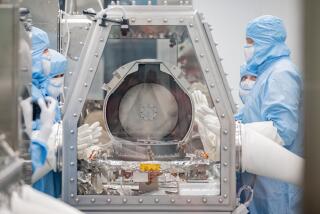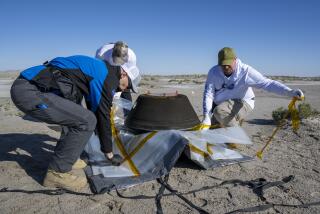Martian Meteorite Redefines ‘Rock Star’
- Share via
SPACE CENTER, Houston — The door to Room 237 has extra locks, a new alarm system and a gray sign that makes it clear what’s inside: Meteorite Processing and Cosmic Dust Laboratories.
The main attraction behind the door at Johnson Space Center’s Building 31 is a controversial 4 1/2-billion-year-old meteorite from Mars. Dubbed ALH84001, it has been there for 12 years, but oh what an announcement about possible life on Mars can do.
“It’s been breathless. It’s just been a yearlong race,” said Marilyn Lindstrom, one of the curators responsible for Room 237. “All of it’s been positive. All of it’s been exciting. But all of it’s been exhausting.”
NASA scientists went public in August 1996 with their belief that ALH84001 contains signs of primitive life on Mars. Many of their colleagues have disputed the claim.
Since the announcement, requests for a look at the rock star and pieces of it for research have intensified. So has security, with extra locks and an added alarm system.
A cabinet-level Japanese official, Russian cosmonauts and the head of the European Space Agency are among 260 people who have gotten a peek at the new celebrity. The public isn’t allowed into the lab.
The rock, a potato-shaped 4.2-pounder when it was discovered in Antarctica in 1984, was launched to Earth when another meteorite struck Mars 16 million years ago.
Since it arrived in Houston in 1985, it has been cut into 300 pieces. The largest weighs 1.5 pounds and the smallest pieces are as tiny as a grain of sand. Half of the pieces, including the biggest one, remain in the Houston lab.
Chips and slices adding up to about a tenth of the meteorite had been distributed to scientists before the announcement. Then dozens of requests came pouring in, and 92 pieces totaling about 7 ounces were sent out this summer after a committee spent months figuring out which researchers should be accommodated.
Lindstrom’s office has been flooded with requests to see ALH84001.
“It’s slowed down, thank goodness,” she said. “The first couple months we were wondering if we were ever going to get done with it.”
Lindstrom escorts visitors and the media into the lab. She gives them white nylon coats and matching hats and booties and leads them into an elevator-size air shower, where filtered air blows off dust.
Inside the main room, the meteorite is found in a stainless steel and glass cabinet. The portion that is usually on display, the second largest, is fist-size and gray.
“It looks so ordinary because it’s mostly one mineral,” Lindstrom said. “In some ways it looks more boring than other meteorites. It’s so blah.”
The announcement about ALH84001 has inspired people from around the world to send rocks to the lab, asking that they be analyzed in case they are meteorites. During a normal year, the lab receives 10 or so such requests. Over the last year, more than 100 have arrived.
Most people get their rocks and a form letter back in the mail.
“I just got a rock from France, but it’s not a meteorite,” lab scientist Cecilia Satterwhite said. “Most people are looking to make a quick buck. They know they’re worth money. They know there’s a market out there.”
There are 12 meteorites in the world that have been identified as Martian, and all of them have become more valuable as a result of the announcement, Lindstrom said. Johnson Space Center has five of them.
Rock ALH84001 is priceless, not only because of the NASA finding but because it is a geologic great-great-great-grandfather compared with others, Lindstrom said.
“This rock is 4 1/2 billion years old. That’s as old as the planet. That’s as old as the solar system, just about,” Lindstrom said. “It’s the very earliest thing that formed on Mars.
“You can get philosophical about that if you want to--you know, that we were supposed to find it,” she added. “You can play whatever kinds of mind games you want with the fact that we’ve got it.”






